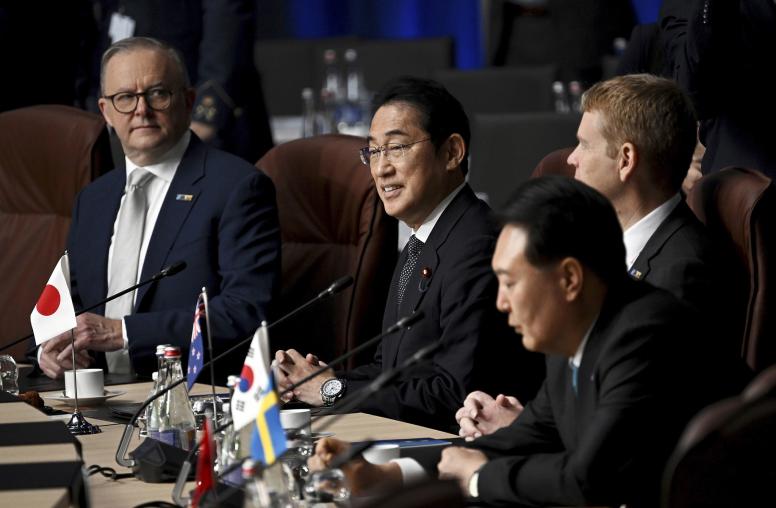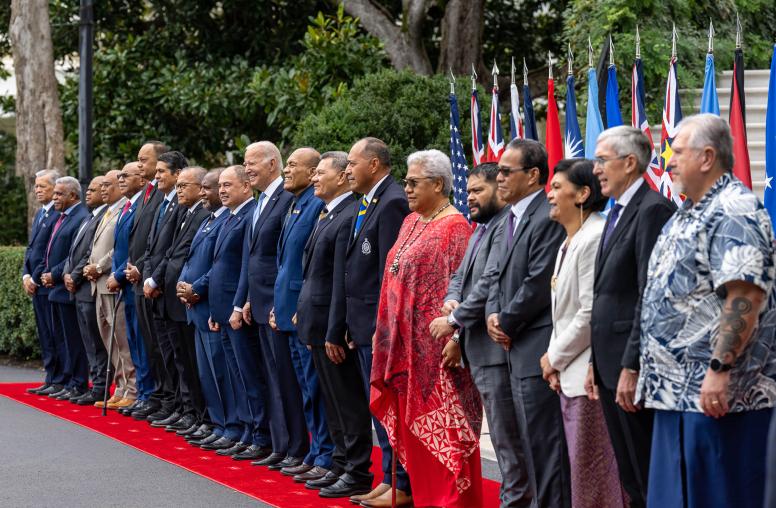Austin, Blinken Affirm U.S. Commitment to Asian Allies
Biden administration seeks to build trust, shore up alliance to counter China.
U.S. Secretary of State Antony J. Blinken and U.S. Defense Secretary Lloyd Austin are in Asia this week for their first official foreign trip. They held meetings in Japan and South Korea. Blinken returned to the United States via Alaska where he and U.S. National Security Advisor Jake Sullivan meet with their Chinese counterparts today, while Austin is in India. On March 12, President Joe Biden and the leaders of Australia, India and Japan participated in a virtual summit of the “Quad,” a strategic dialogue between the four countries aimed at ensuring an open, free and prosperous Indo-Pacific region.

USIP’s Patricia Kim, Frank Aum, Vikram Singh and Brian Harding discuss the significance of the choice of destinations for Blinken and Austin’s trip and to what extent it is aimed at shoring up an alliance to counter China.
To what extent is this trip an effort by the Biden administration to shore up alliances to counter China?
Kim: The Biden administration has framed the Quad summit and its outreach to Asian allies and partners this week as a means to consult and coordinate with key partners on an array of global and regional issues, and not just on the challenges posed by China. As outlined in the joint statement on the “Spirit of the Quad,” the objective is to strive for a region that is “free, open, inclusive, healthy, anchored by democratic values, and unconstrained by coercion.” This will require enhancing coordination across the economic, diplomatic and military dimensions within the Quad and with other partners, like South Korea, to effectively compete with China and to work toward a constructive balance of power in the region, while addressing many other pressing challenges including the COVID-19 pandemic, climate change and the nuclear threat posed by North Korea.
What can we expect from Secretary of State Blinken and National Security Advisor Sullivan’s meeting with their Chinese counterparts in Alaska?
Kim: The U.S.-China bilateral meeting in Alaska will likely set the tone and the contours of the bilateral trajectory for the near term and impact the China policy review that is happening now within the U.S. government. The dynamics and outcome of the meeting will begin to reveal whether the U.S.-China relationship can simultaneously compete in some domains while collaborating in others, as leaders in both states have emphasized is necessary, or whether compartmentalizing the adversarial and cooperative aspects of the relationship will prove to be difficult to operationalize in reality.
Why is it significant that Secretary of State Blinken and Defense Secretary Austin’s first foreign trip was to South Korea and Japan?
Aum: Secretary Blinken and Secretary Austin’s decision to travel together to Japan and South Korea for their first trip abroad signals several things: the paramount importance that the Biden administration places on the Indo-Pacific region, the comprehensive scope of issues involved in the United States’ Indo-Pacific strategy, how our alliances there form the foundation of our regional strategy and U.S. concerns about China’s destabilizing behavior in multiple domains.
The Biden administration will be seeking to reinvigorate U.S. alliances and multilateral cooperation amid growing tensions between Washington and Beijing and the ongoing review of U.S. policy toward North Korea. The previous U.S. administration implemented a more unilateral approach that was oftentimes critical of allied contributions to defense cost sharing and caused unnecessary friction in alliance relationships.
The effort to resolve alliance frictions has already started off on the right foot, with the recent U.S.-ROK agreement on defense cost sharing and the one-year extension of the U.S.-Japan Host Nation Support agreement. Washington and Tokyo are largely on the same page on many issues, including advancing the concept of a free and open Indo-Pacific, strengthening the Quad mechanism and maintaining pressure on North Korea to achieve its complete denuclearization. However, the United States faces pushback from South Korea, which has demurred on joining any regional effort that appears to exclude or gang up on China and prefers a more aggressive engagement-based approach to North Korea. The alliance meetings will likely also discuss ways to enhance cooperation on other issues, such as climate change, COVID-19 vaccine access, economic cooperation and the situation in Myanmar.
What is the significance of Austin’s trip to India?
Singh: Austin’s trip reinforces the Biden administration’s commitment to the Major Defense Partnership with India and Indo-Pacific security. It is significant that the first foreign trip by the new defense secretary includes India, especially following on engagements with Quad partners — Japan and Australia — and South Korea.
Increasing cooperation between the United States and India is fundamental to the ability of the Quad to engage in meaningful action on everything from climate change to maritime security. Austin will be in New Delhi at the same time as Blinken and Sullivan will be meeting their Chinese counterparts in Alaska, showing solidarity with a partner that has also gone through a period of historic lows in its relations with China. The Chinese will see Austin’s visit and the Quad and 2+2 meetings as signal that the United States is standing steadfast with its allies.
What do you expect will be on the agenda in New Delhi?
Singh: In New Delhi, Austin’s meetings will likely focus on regional stability and managing challenges from China, especially in light of India’s own recent border tensions with China. They will cover traditional areas of cooperation — counterterrorism, maritime security, humanitarian assistance, and defense trade and technology cooperation. Following up on the outcomes of the Quad leaders’ summit will also be a major component. The militaries of both countries have a key role in climate resilience and health/pandemic security. They are also drivers of emerging technology cooperation and increased intelligence sharing. And, as always, Austin and his Indian interlocutors will discuss concerns about Afghanistan and India’s relationship with Pakistan. With regard to both Pakistan and China, the United States will welcome the recent reductions in tensions and likely offer support for any additional steps toward long-term stability.
What came out of the first summit-level meeting of the Quad last week?
Harding: The March 12 Quad meeting was the first meeting of the grouping to take place at the leader level and demonstrated the priority the United States, Australia, India and Japan are placing on cooperation and alignment among the four countries to address challenges associated with a rising China. As Biden’s first multilateral meeting, it was also another signal regarding the priority the administration intends to place on the Indo-Pacific and the primacy of working with allies and partners in its approach to the region.
Beyond the symbolism, the meeting made significant progress in establishing an affirmative, substantive agenda for the Quad, with a focus on providing public goods for the Indo-Pacific region related to health security, climate change and other transnational challenges. The most important outcome on this front was an ambitious initiative to jointly deliver one billion doses of COVID-19 vaccines by the end of 2022, with a focus on distribution in Southeast Asia. The priority given to Southeast Asia reflects the region’s importance in terms of competition with China as well as the need for economic recovery in Southeast Asia to boost growth more broadly in region. In addition to setting up a working group on vaccines, the leaders also launched working groups on climate change and emerging technologies, with an eye toward China on the latter.
While the vaccine initiative is welcome news for Southeast Asia, its speed and effectiveness will be watched closely, especially with Chinese vaccines already arriving in the region. And despite the leaders’ nod to the importance of ASEAN (the Association of Southeast Asian Nations), the growing centrality of the Quad will increasingly pose a challenge for Southeast Asia, where leaders have sought to place ASEAN at the center of Asia-Pacific, and now Indo-Pacific, regionalism.



